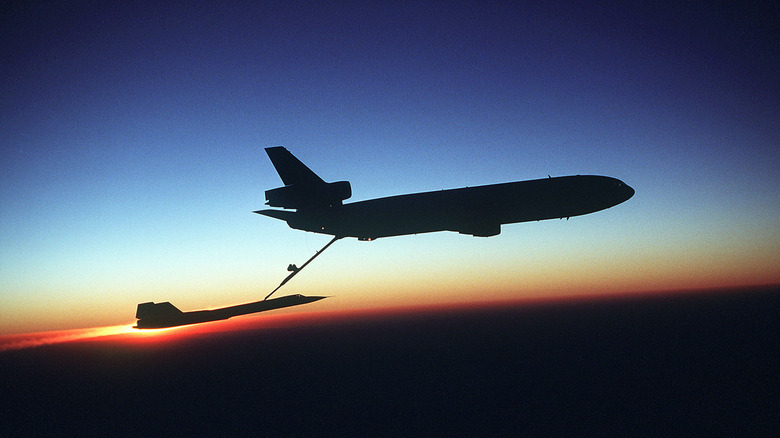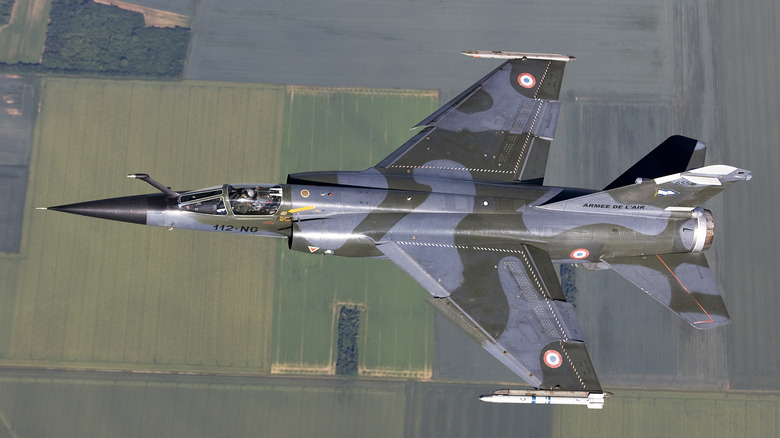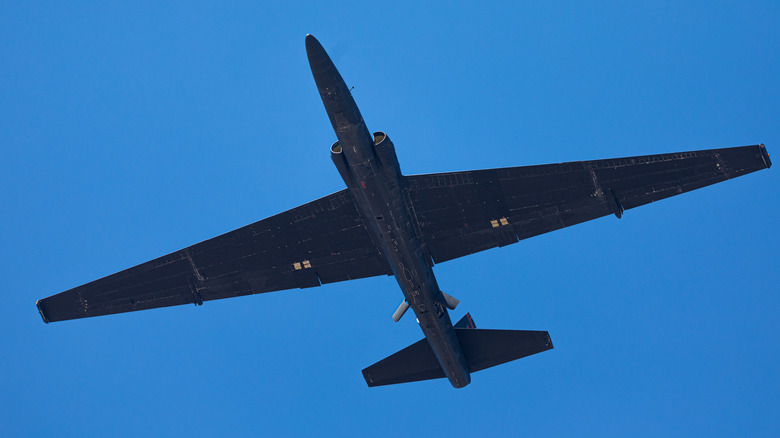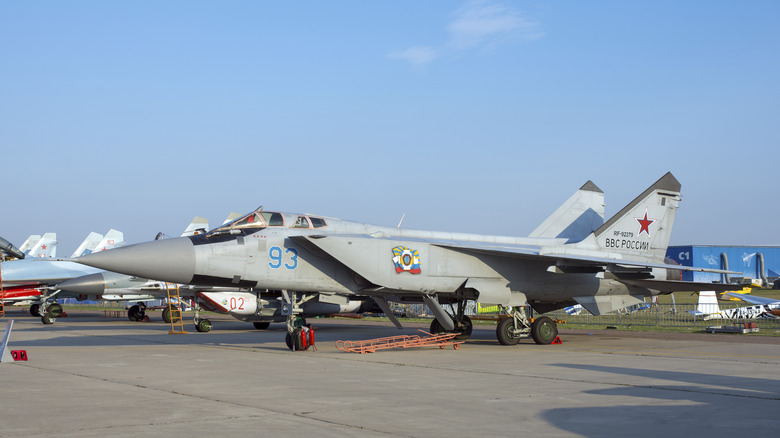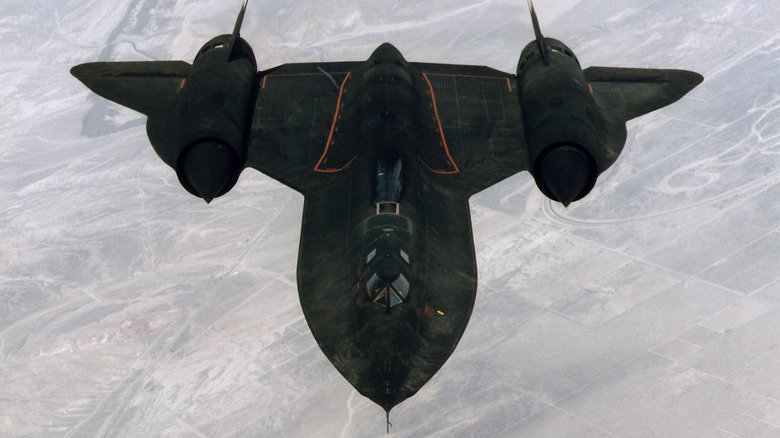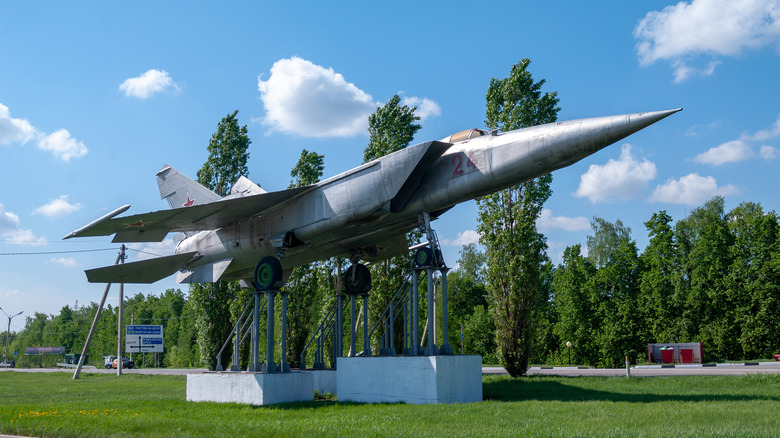5 Of The Highest-Flying Military Jets To Ever Hit The Skies
What usually impresses the general public about military aircraft is their speed. Why wouldn't you be impressed? These are human-made objects traveling faster than the speed of sound, causing sonic booms — and there's a human being sitting in the cockpit withstanding the G-force such speed brings about. But the maximum altitude a plane can reach is equally impressive and offers unique opportunities for pilots and researchers alike. Commercial airlines typically fly anywhere between 31,000 and 42,000 feet, but that's nothing compared to some fighter jets.
Flying at a high altitude has advantages. It gives sensors a wide view of a target and lets pilots fly over bad weather, and certain studies can be conducted for science.
Not all of the following jets are in service any longer, but some are still flying despite their age. Before you start wondering why Robert White and the X-15's record-breaking flight at 314,688 feet from 1962 isn't listed here, that's technically a rocket, and an experimental one at that. These planes were actively used by a country's military in some capacity.
Dassault's Mirage F1 flies higher than the F-22 and F-35
Dassault Aviation is a French aerospace company known for delivering widely used fighter jets such as the Rafale to countries around the world. Dassault's Mirage F1 came with a few alterations to the company's typical design choices. For starters, unlike the delta-winged Mirage III, which it was built to replace, the F1 has a swept-wing design with the wings positioned high on the fuselage. This helps the plane land at lower speeds than a delta-wing design allows.
The Mirage F1 had its maiden flight in 1964 but didn't enter service with the French Air Force until 1974 . It was built with a single Snecma Atar 9K-50 turbojet capable of producing nearly 16,000 pounds of thrust. Its maximum speed is greater than Mach 2.
The Mirage F1 can reach a maximum altitude of 60,700 feet, which can be beneficial for an all-weather fighter jet, and is significantly higher America's F-22 Raptor and F-35A LIghtning 2. This is significant since both American planes are fifth-generation fighters while the Mirage F1 is not. While a jet's service ceiling isn't a measure of its overall worth, it's impressive that an older aircraft can fly higher than the most advanced jets in modern times. The Air Force lists both fifth-gen jets' service ceiling as "above 50,000 feet." It might not list the exact ceiling for national security reasons, but what's listed is usually the highest the jet can safely fly.
The U-2 Dragon Lady has a longstanding history of reliability
Lockheed's Skunk Works secretly worked on the development of the U-2 surveillance aircraft in the 1950s, with its maiden flight taking place in 1955. Despite being built in secret, it eventually became the best-known high-altitude spy plane in history, becoming famed in 1960 when pilot Francis Gary Powers was shot down in one over the Soviet Union, scuttling a planned U.S.-Soviet summit.
The U2 earned favor with both the CIA and U.S. Air Force; even the U.S. Navy wanted to use the Dragon Lady and got one to land on an aircraft carrier. This spy plane has consistently proven its reliability, and the Air Force has continually found a reason to fly the U-2 for nearly seven decades, including using it in Iraq and Afghanistan to spot signs of mines and roadside bombs. Impressive for a plane that wasn't expected to last longer than two years. It's now expected to retire sometime in 2026.
As a spy plane that needed to fly over hostile regions without being detected, the U-2 had to regularly fly at altitudes exceeding 70,000 feet. Beyond its military operations, NASA operates modified U-2s to study the atmosphere. The Dragon Lady is no stranger to studying the atmosphere since the CIA originally used it during the Cold War to monitor the upper atmosphere for evidence of nuclear weapons tests.
MiG-31 has the highest service ceiling for fighter jets
The MiG-31 Foxhound is a derivative of the MiG-25 Foxbat fighter jet, but with better digital avionics. This interceptor has been serving the Russian and Kazahkstan Air Forces since the '70s. Overcoming several deficiencies the Foxbat exhibited, the MiG-31 was built with two efficient Solovyev D-30F6 low-bypass-ratio turbofan engines. Each engine could produce 21,000 pounds of thrust dry. Meanwhile, with the afterburner, they can each push out 34,000 pounds of thrust. It's within the realm of possibility for the Foxhound to reach Mach 3.2. However, it's not exactly safe for the pilot to do so, so Mach 2.83 is its recommended maximum.
When it comes to altitude, though, it can nearly fly as high as America's SR-71 Blackbird, reaching 82,000 feet, climbing at a rate of 944 feet every second. In July 2020, Russia initiated a modernization and life-extension program for the MiG-31, which it still flies in its Air Force and relies on it extensively during its war with Ukraine. Ukraine doesn't currently have fighter jets that can rival the speed and service ceiling of the Foxhound. So while Ukraine might be sinking numerous Russian warships, it's not as well prepared for the skies.
Few jets could compete with the SR-71 Blackbird
Few planes could reach the same heights as the SR-71 Blackbird, much less as easily as it could. Its two Pratt & Whitney J58 axial-flow turbojet engines that each produced 32,500 pounds of thrust not only let the spy plane cruise at 2,200 miles per hour, making the SR-71 Blackbird fastest jet ever made, it could reach a service ceiling of 85,000 feet. From that altitude, the Blackbird could surveil roughly 100,000 square miles each hour. While the Blackbird was a great reconnaissance tool, it didn't provide the same cost-efficiency as the U-2, costing the American government anywhere between $200 million and $300 million a year to operate.
Traveling to 85,000 feet posed several problems for Lockheed's designers, too. While at that altitude the temperature around the aircraft would be minus 60 degrees, flying so fast also meant that extreme heat would be a problem. Skunk Works had to build the airframe primarily out of titanium, and its brittleness caused problems of their own. It also required a specialized life support system and spacesuit-like garb.
Despite the Air Force retiring the SR-71 in the '90s, NASA continued using it until 1999 because climbing up to 85,000 feet as well as traveling three times faster than the speed of sound provided unique research opportunities.
The MiG-25 holds the world record
The SR-71 Blackbird is the most widely known jet to reach an impressive altitude, but it doesn't hold the record. That title goes to the Mikoyan-Gurevich (MiG)-25 Foxbat jet, a supersonic fighter also used by the Soviet Union for reconnaissance. Not just any MiG-25, however. Off the assembly line, this fighter jet could already reach an impressive 79,000-foot service ceiling and speeds of Mach 2.83. However, in the same year "Star Wars" debuted, test pilot and "Hero of the Soviet Union" Alexandr Vasilievich Fedotov hopped into the cockpit of a modified MiG-25RB and took it up to an altitude of 123,523 feet. For some perspective, that's 23.4 miles; Mount Everest's peak is only 29,032 feet (5.5 miles).
But his was an experimental Foxbat that used R15BF2-300 engines rather than the stock R-15B-300 single-shaft turbojets. According to Guinness World Records, "The altitude was reached during a near-vertical climb." A conventional Foxbat, though, was barely reliable enough to reach its usual service ceiling and could only do so for a couple of minutes, without any missiles attached. While the MiG-25RB was an experimental aircraft at the time of the record, the USSR went on to use it as a tactical bomber.
